|
|
|
|
 |
ANGUISSOLA Sofonisba
|
|
Italian Mannerist Painter, 1532-1625
The best known of the sisters, she was trained, with Elena, by Campi and Gatti. Most of Vasari's account of his visit to the Anguissola family is devoted to Sofonisba, about whom he wrote: 'Anguissola has shown greater application and better grace than any other woman of our age in her endeavours at drawing; she has thus succeeded not only in drawing, colouring and painting from nature, and copying excellently from others, but by herself has created rare and very beautiful paintings'. Sofonisba's privileged background was unusual among woman artists of the 16th century, most of whom, like Lavinia Fontana (see FONTANA (ii),(2)), FEDE GALIZIA and Barbara Longhi (see LONGHI (i), (3)), were daughters of painters. Her social class did not, however, enable her to transcend the constraints of her sex. Without the possibility of studying anatomy, or drawing from life, she could not undertake the complex multi-figure compositions required for large-scale religious or history paintings. She turned instead to the models accessible to her, exploring a new type of portraiture with sitters in informal domestic settings. The influence of Campi, whose reputation was based on portraiture, is evident in her early works, such as the Self-portrait (Florence, Uffizi). Her work was allied to the worldly tradition of Cremona, much influenced by the art of Parma and Mantua, in which even religious works were imbued with extreme delicacy and charm. From Gatti she seems to have absorbed elements reminiscent of Correggio, beginning a trend that became marked in Cremonese painting of the late 16th century. This new direction is reflected in Lucia, Minerva and Europa Anguissola Playing Chess (1555; Poznan, N. Mus.) in which portraiture merges into a quasi-genre scene, a characteristic derived from Brescian models. |
|
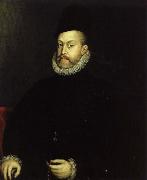 |
anguissola sofonisba
|
|
The best known of the sisters, she was trained, with Elena, by Campi and Gatti. Most of Vasari's account of his visit to the Anguissola family is devoted to Sofonisba, about whom he wrote: 'Anguissola has shown greater application and better grace than any other woman of our age in her endeavours at drawing; she has thus succeeded not only in drawing, colouring and painting from nature, and copying excellently from others, but by herself has created rare and very beautiful paintings'. Sofonisba's privileged background was unusual among woman artists of the 16th century, most of whom, like Lavinia Fontana (see FONTANA (ii),(2)), FEDE GALIZIA and Barbara Longhi (see LONGHI (i), (3)), were daughters of painters. Her social class did not, however, enable her to transcend the constraints of her sex. Without the possibility of studying anatomy, or drawing from life, she could not undertake the complex multi-figure compositions required for large-scale religious or history paintings. She turned instead to the models accessible to her, exploring a new type of portraiture with sitters in informal domestic settings. The influence of Campi, whose reputation was based on portraiture, is evident in her early works, such as the Self-portrait (Florence, Uffizi). Her work was allied to the worldly tradition of Cremona, much influenced by the art of Parma and Mantua, in which even religious works were imbued with extreme delicacy and charm. From Gatti she seems to have absorbed elements reminiscent of Correggio, beginning a trend that became marked in Cremonese painting of the late 16th century. This new direction is reflected in Lucia, Minerva and Europa Anguissola Playing Chess (1555; Poznan, N. Mus.) in which portraiture merges into a quasi-genre scene, a characteristic derived from Brescian models.
|
|
|
|
 |
Aniello Falcone
|
|
(1600-1665) was an Italian Baroque painter, active in Naples and noted for his painted depictions of battle scenes.
Born in Naples the son of a tradesman, he showed his artistic tendency at an early age. He first received some instruction from a relative, and then became one of the most prominent pupils apprenticed under Jose de Ribera. Salvatore Rosa, in turn, is said to have apprenticed under Aniello.
The Anchorite, ca. 1650 Wikimedia Commons has media related to: Aniello Falcone
Besides battle pictures, large and small, taken from biblical as well as secular history, he painted various religious subjects, which, however, count for little in his general reputation. He became, as a battle painter, almost as celebrated as Giacomo Borgognone, and was named L' Oracolo delle Battaglie. His works have animation, variety, truth to nature, and careful color.
Falcone was bold, generous, accustomed to arms, and an excellent fencer. In the insurrection of 1647, led by Masaniello, he resolved to be bloodily avenged for the death, at the hands of two Spaniards, of a nephew and of a pupil in the school of art which he had established in Naples. Salvator Rosa, Carlo Coppola, among others, and he formed an armed band named the Compagnia della Morte, or Company of Death. (See Salvator Rosa.) They battled in the streets by day; at night they were painters again, and handled the brush with impetuous zeal.
Rule restored, they decamped. Falcone and Rosa made off to Rome; here Borgognone noticed the works of Falcone, and became his friend, and a French gentleman induced him to go to France, where Louis XIV became one of his patrons. Ultimately Jean-Baptiste Colbert obtained permission for the painter to return to Naples, and there he died in 1665. |
|
|
|
|
|
 |
Anna Ancher
|
|
Danish Painter, 1859-1935
was the only one of the Skagen Painters that was actually born in Skagen, Denmark. Anna Ancher was born and grew up in the northernmost area of Jutland, called Skagen (the Skaw). Her talent became obvious at an early age and she grew acquainted with pictorial art via the many artists who settled to paint in Skagen. Anna Ancher studied drawing for 3 years at the Vilhelm Kyhn College of Painting in Copenhagen. However, Anna Ancher developed her own style and was a pioneer in observing the interplay of different colours in natural light. She also studied drawing in Paris at the atelier of Pierre Puvis de Chavannes along with Marie Triepcke, who would marry Peder Severin Krøyer, another Skagen painter. In 1880 she married fellow painter Michael Ancher, whom she met in Skagen. They had one daughter, Helga Ancher. Despite pressure from society that married women should devote themselves to household duties, she continued painting after marriage. Anna Ancher is considered to be one of the great Danish pictorial artists by virtue of her abilities as a character painter and colourist[citation needed]. Anna Ancher's art found its expression in Nordic art's modern breakthrough towards a more truthful depiction of reality, e.g. in Blue Ane (1882) and The Girl in the Kitchen (1883-1886). Anna Ancher preferred to paint interiors and simple themes from the everyday lives of the Skagen people and fishermen, |
|
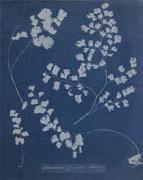 |
Anna Atkins
|
|
Tonbridge 1799-1871 Tonbridge,English botanist and pioneer of the photogram and photographic publishing. Daughter of the prominent scientist John George Children, Atkins was encouraged by him in her scientific interests. She was a competent watercolourist and published at least one lithograph. By 1823 her draughtsmanship and observational skills were refined enough for her to produce 200 illustrations for her father's translation of Lamarck's Genera of Shells. Botany was her particular love, especially the collection and study of seaweeds. Her father chaired the February 1839 Royal Society meeting at which Henry Talbot first revealed the manipulatory secrets of photogenic drawing. Father and daughter soon got a camera and took up the new art of photography, but Atkins's biggest contribution to it involved neither a camera nor her father. She conceived the idea of publishing a photographic record of her algae, making photograms by contact printing the dried specimens on sheets of sensitized paper. |
|
|
|
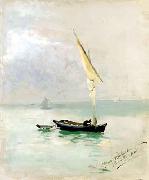 |
Anna Bilinska-Bohdanowicz
|
|
(1857-1893) was a Polish painter, known for her portraits. She was born as Anna Biliska, a daughter of Polish doctor in Ukraine, where she spent her childhood. She lived with her father in Russia, before studying music and art in Warsaw.
She went later to study at the Academie Julian in Paris. She lived in France until 1892, when she married a medical doctor named Bohdanowicz and she took his name (Anna Bilieska-Bohdanowicz).
They returned to Warsaw after their marriage, where she died a year later of heart attack.
Her paintings are known from the reproductions of her portraits of women and often reproduced view of the Unter den Linden in Berlin from 1890.
|
|
|
|
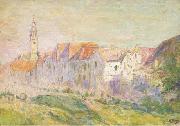 |
Anna Boch
|
|
(10 February 1848 - 25 February 1936) was a Belgian painter, born in Saint-Vaast, Hainaut. Anna Boch died in Ixelles in 1936 and is interred there in the Ixelles Cemetery, Brussels, Belgium.
Boch participated in the Neo-Impressionist movement. Her early works used a Pointillist technique, but she is best known for her Impressionist style which she adopted for most of her career. A pupil of Isidore Verheyden, she was influenced by Theo van Rysselberghe whom she met in the Groupe des XX.
|
|
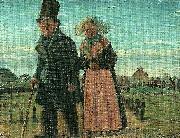 |
anna brondum
|
|
Omkring 1900 drog en rad av kvinnliga konstnärer från Norden mot Frankrike, Italien, Tyskland och andra länder i Europa. Hanna Pauli, Sigrid Hjerten och Anna Bröndum är i dag kända, men den vårgårdafödda Hilda Heyman hörde också till dessa målande kvinnor. Hon är inte så känd men väl erkänd i konstnärliga kretsar och representerad på många konstmuseer. |
|
|
|
|
|
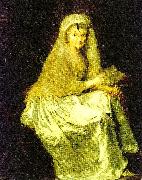 |
anna dorothea lisiewska therbusch
|
|
Lisiewski, Anna Dorothea (von) / Lisiewska-Therbusch, Anna Dorothea / Liszeswka, Anna Dorothea.
Anna Dorothea Therbusch (somtetimes Anna Dorothea Therbusch-Lisiewska, or Lisiervska/Lisziewska/Liesiewka (1721-1782) was a German painter.
|
|
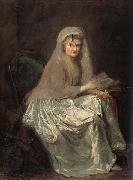 |
anna dorothea therbusch
|
|
1721-82
German painter of Polish descent. She was taught by her father, the portrait painter Georg Lisiewski (1674-1751), and received further training from Antoine Pesne in Paris. She worked for Charles-Eugene, Count of W?rttemberg, in Stuttgart from 1761 to 1762, and for Charles Theodore Wittelsbach, Elector Palatine of the Rhine, in Mannheim from 1763 to 1764. In 1765 she returned, via Stuttgart and Hohenzollern-Hechingen, to Paris, where in 1767 she became a member of the Academie Royale. She met Denis Diderot and Philipp Hackert, both of whom she painted, and Charles-Nicolas Cochin , but, despite consistent support from Prince Galitsyn, she was unable to establish herself in Paris. In 1769 she returned to Berlin where she received commissions for mythological paintings (e.g. Diana and her Nymphs, 1771; Potsdam, Neues Pal.) from Frederick II, King of Prussia. She painted portraits of members of the Prussian court, and the Berlin bourgeoisie, and in 1773 was commissioned by Catherine II, Empress of Russia, to paint a portrait of the Prussian royal family. |
|
 |
Anna Elizabeth Klumpke
|
|
1856-1942
Anna Elizabeth Klumpke (October 28, 1856?C1942) was American portrait and genre painter born in San Francisco, California, United States. She is perhaps best known for her portraits of famous women including Rosa Bonheur and Elizabeth Cady Stanton (1889).
Her father, John Gerald Klumpke, born in England or Germany , was a successful and wealthy realtor in San Francisco. Her mother was Dorothea Mattilda Tolle. Anna was the eldest of eight children, five of whom lived to maturity. Among her siblings were the astronomer Dorothea Klumpke-Roberts, the violinist Julia Klumpke, and the neurologist Augusta D??jerine-Klumpke.
At age three, Anna fell and suffered a fracture of her femur. She fell again at age five and suffered osteomyelitis with purulent knee arthritis. It handicapped her, and her mother took extraordinary means to remeded the problem by taking Anna and three siblings to Berlin for treatment by Dr. Bernhard von Langenbeck.
The treatments lasted 18 months, including thermal baths at Kreuznach, but unfortunately they were not successful, and she would remained hobbled all her life. While in Europe, her mother ensured that all of her children had excellent tutoring.
The time away in Europe placed a strain on the relationship of her parents. When Anna was fifteen, her parents divorced. She and her siblings (now numbering five) moved with their mother to Göttingen, Germany, where they lived for a time with Mattilda's sister, who had married a German national. Anna and her sister Augusta were sent to school at Cannstatt, near Stuttgart. At age seventeen, the family moved to Clarens, near Lake Geneva in Switzerland where she spent two years in boarding school. She studied art at home for the next few years, and in October 1877, moved with her family once more to Paris, where she was later enrolled in the Julian Academy (1883-1884), under the tutelage of Tony Robert-Fleury and Jules Lefebvre. At one point she also studied under Vuillefroy. She presented her first work at the Paris Salon in 1884, while still at the Academy, and she won the grand prize for outstanding student of the year. She showed regularly at the Salon for several more years. |
|
|
|
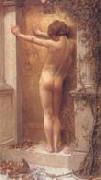 |
Anna Lea Merritt
|
|
American Pre-Raphaelite Painter, 1844-1930
English painter, muralist and printmaker of American birth. She is best known for her Victorian portraits, allegorical and religious paintings, landscapes and floral scenes and was successful in spite of the difficulties that she encountered as a professional woman artist working in Victorian England. After brief artistic tours to Florence, Dresden and Paris, where she studied in L?on Cogniet's atelier, she began intensive instruction in 1870 from Henry Merritt (1822-77), an Englishman who restored works of art from important collections and wrote on art, exhibitions and conservation. Anna Lea and Henry Merritt were married in July 1877; three months later he died. Love Locked out (1889; London, Tate), depicting love at the door of a tomb, was painted as a memorial to her husband. |
|
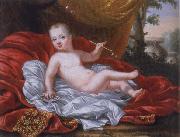 |
Anna Maria Ehrenstrahl
|
|
1666-1729,as married Wattrang, (1666-1729), was Swedish painter, the first female painter in her country. She was a baroque-artist and painted allegorys, portraits and group portraits in the style of the Baroque. Born as child of the court painter David Klocker Ehrenstrahl and Maria Momma, she was instructed as a student by her father to copy and finish his works and to paint details and other such smaller things to complete the paintings in his studio. She is confirmed as her fathers assistant from ca 1680. Her learning as an artist was therefore not complete, as he never intended her to become an independent artist, just as a form of artistic secretary in his studio, but she was in fact to create paintings herself eventually. In 1688 she married Johan Wattrang, vice president in Svea Hovratt, and painted six portraits of this courts former presidents, which she gave the court signed with her own name (1717). Her way of painting was in the same barocque style as her father; she painted allergorys and portraits of both single people and groups, bot real people and mytholocigal figures in the style of the time. Among them was portraits of king Charles XI of Sweden, Prince Ulrik (in 1685), an allegory over the four seasons (1687) and an allegory of Cupid and Psyche. She painted the four king's under her lifetime, the Princes Gustaf and Fredrik, Ulrika Eleonora of Denmark and Aurora Konigsmarck. |
|
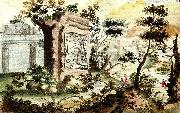 |
anna maria thelott
|
|
Anna Maria Thelott, född 1683, död 1710, var en svensk konstnär. Thelott var en av de första självförsörjande och professionella kvinnliga konstnärerna i Skandinavien.
Anna Maria Thelott var dotter till instrumentmakaren och konstnären Philip Jacob Thelott d.ä., som ursprungligen kom från Schweiz, och syster till konstnären Philip Jacob Thelott d.y. Hon arbetade redan som barn sin med far och sina bröder i arbetet med att illustrera Olof Rudbeck d.ä.:s "Campus Elysii" och "Atlantica", och bidrog snart till hushållets försörjning genom att ensam utföra olika konstnärliga arbeten mot betalning, vilket gjorde henne till landets troligen första kvinnliga yrkeskonstnär.
Familjen bodde ursprungligen i Uppsala, men flyttade år 1702 till Stockholm efter den stora stadsbranden då en stor del av Uppsala brann ned.
Thelott var en mångsidig konstnär som var kunnig på en rad områden; hon utförde träsnitt och kopparstick förutom teckning och illustrationer med allegoriska och religiösa motiv, miniatyrer och bilder av djur och landskapsmålningar. Hon utförde elva träsnitt av tyska städer med tillhörande informativ text på uppdrag av Posttidningen år 1706 och anlitades för att illustrera Peringskiölds arbeten.
År 1710 dog Anna Maria Thelott i Stockholm som en av många offer för den sista pesten i Sverige. På Uppsala universitetsbibliotek finns en skissbok av henne utförd 1704-1709. |
|
|
|
|
|
|
|
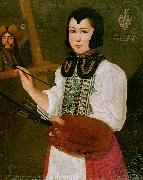 |
Anna Waser
|
|
Anna Waser (1678 - 1714) was a Swiss painter . |
|
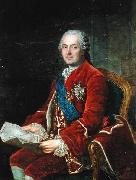 |
Anne Baptiste Nivelon
|
|
Portrait de Louis de France, dauphin (1729 - 1765) represente tenant des plans militaires |
|
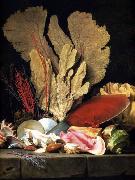 |
Anne Vallayer-Coster
|
|
French Rococo Era Painter, 1744-1818,was an eighteenth-century French painter. Known as a prodigy artist at a young age, she achieved fame and recognition very early in her career, being admitted to the Royal Academy in 1770, at the age of twenty-six.
Despite the negative reputation that still-life painting had at this time, Vallayer-Coster??s highly developed skills, especially in the depiction of flowers, soon generated a great deal of attention from collectors and other artists. Her precocious talent and the rave reviews?? earned her the attention of the court, where Marie Antoinette took a particular interest in Vallayer-Coster's paintings.
Regardless of her closeness to the ancient regime and France's hated monarch she survived the bloodshed of the French Revolution. However, the fall of the French monarchy, which were her primary patrons, caused her banishment into the shadows.
Anne Vallayer-Coster was a woman in a man??s world. It is unknown what she thought of contemporaries who admitted her to the confraternity, and made her an honorary ??man??. Her life was determinedly private, dignified and hard-working. Occasionally she attempted other genres, but for the usual reasons her success at figure painting was limited
|
|
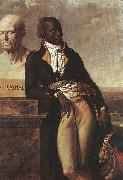 |
Anne-Louis Girodet de Roussy-Trioson
|
|
(also given as Anne-Louis Girodet de Roucy-Triosson, Anne-Louis Girodet-Trioson) January 5, 1767 - December 9, 1824), was a French painter and pupil of Jacques-Louis David, who was part of the beginning of the Romantic movement by adding elements of eroticism through his paintings. Girodet is remembered for his precise and clear style and for his paintings of members of the Napoleonic family.
|
|
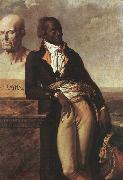 |
Anne-Louis Girodet-Trioson
|
|
1767-1824
French
Anne Louis Girodet Trioson Galleries
Girodet was born at Montargis. He lost his parents in early youth and the care of his inheritance and education fell to his guardian, M. Trioson, "medecin-de-mesdames," by whom he was in later life adopted and whose surname he took in 1812. He started in school by studying architecture and pursuing a military career. He later changed to the study of painting under a painter named Luquin, before entering the school of David. From 1789 to 1793 he lived in Italy where, at the age of twenty-two, he successfully competed for the Prix de Rome thus making a name for himself for his painting of the Story of Joseph and his Brethren. At Rome he painted his Hippocrate refusant les presents d'Artaxerxes and Endymion-dormant (presently held in the Louvre), work which was praised at the Salon of 1793. |
|
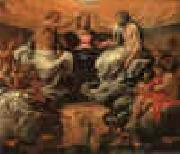 |
Annibale Carracci
|
|
1560-1609
Italian
Annibale Carracci Locations
Painter, draughtsman and printmaker, brother of (2) Agostino Carracci. Since his lifetime, he has been considered one of the greatest Italian painters of his age. His masterpiece, the ceiling (1597-1601) of the Galleria Farnese, Rome, merges a vibrant naturalism with the formal language of classicism in a grand and monumental style. Annibale was also instrumental in evolving the ideal, classical landscape and is generally credited with the invention of CARICATURE. |
|
|
|
|
|
|
|
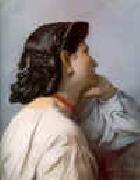 |
Anselm Feuerbach
|
|
1829-1880
German
Anselm Feuerbach Location
German painter. He studied in Germany, Paris, and Rome, spending much of his life in Italy. He sought to produce works of pure classicism that were both didactic and idealistic. Most of his famous works belong to his Roman period (1856?C73), including Battle of the Amazons (Nuremberg), Iphigenia (Stuttgart), and Medea (Munich). His portraits have withstood critical opinion better than his history paintings. His autobiography (1882) emphasizes his misunderstood genius. |
|
|
|
|
|
|
|
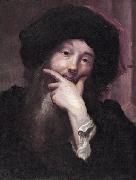 |
Anthoni Schoonjans
|
|
(1655 - 13 August 1726) was a Flemish painter.
He was born in Antwerp and became a pupil of Erasmus Quellinus II and his son Jan-Erasmus Quellinus. He travelled to Rome and like his teachers had done before him, joined the Bentvueghels with the nickname "Parrhasius" in 1674. In Rome he lived with Charles de Vogelaer in the via Margutta and later he lived from 1688-89 in the Corso, near the via di Ripetta. In 1695 he became court painter in Vienna, where he later died. During the course of his lengthy career he also worked in Antwerp, Riems, Lyon, Amsterdam, the Hague, Brno, Dusseldorf, Copenhagen, and Berlin.He is known for portraits and historical allegories, and was the teacher of Georg Gsell. |
|
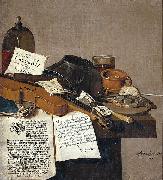 |
Anthonie Leemans
|
|
(1631, The Hague - 1673, Amsterdam), was a Dutch Golden Age painter.
According to Houbraken, who did not specify which brother he meant, he made a profitable living making trompe l'oeil paintings of hunting paraphernalia, birdcages, and weaponry.
According to the RKD he was the older brother of the painter Johannes Leemans, and both are known for still life paintings of hunting paraphernalia and vanitas pieces that became an influence on Christoffel Pierson for their popularity. Anthonie also painted a few Italianate landscapes with soldiers.
|
|
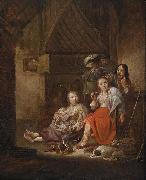 |
Anthonie Palamedesz
|
|
, also Anthonie or Antonie Palamedesz., (1601, Delft - ca 27 November 1673, Amsterdam), was a Dutch Golden Age portrait painter.
According to Houbraken his father was a Flemish sculptor who carved semi-precious stone such as Jasper, Porphyry, and Agate into vases and other decorative art. His father had traveled to England in service of King James of Scotland, but after Anthonie's older brother Palamedes was born, the family returned to Delft where the boys grew up. Anthonie survived his brother Palamedes who died young in 1638. He entered the Delft Guild of St. Luke in 1636 and was in 1673 hoofdman or deacon of that guild for the last time.
Palamedes primarily painted portraits and genre works, while his brother Palamedes Palamedesz. I was a battle scene painter. According to the RKD, Anthonie was the oldest brother, taught by Michiel Jansz. van Mierevelt and Hans Jordaens and had joined the Delft Guild of Saint Luke already in 1621. He was married twice, and had four children in total. His pupils were his younger brother Palamedes, his own son Palamedes II, and the painter Ludolf de Jongh. Anthonie died in Amsterdam in 1673.
|
|
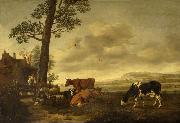 |
Anthonie van Borssom
|
|
(January 2, 1631, Amsterdam - march 19, 1677, Amsterdam), was a Dutch Golden Age landscape painter.
According to the RKD he was an Italianate landscape painter who copied works of popular landscape painters of his day in Amsterdam such as Jacob van Ruisdael, Paulus Potter, Aelbert Cuyp (church interieurs), Nicolaes Berchem, Philips Koninck, Jan Wijnants, Aert van der Neer (moonlit landscapes), and Cornelis Vroom. He lived and worked in Amsterdam but made a trip in 1650-1655 along the Rhine and spent time in Kleve.He was buried in the Westerkerk. |
|
 |
Anthonie van Montfoort
|
|
(Montfoort, 1533 or 1534 - Utrecht, 1583) was a Dutch painter
His father was a mayor of Montfoort. He went to learn under Hendrick Sweersz. in Delft and Frans Floris in Antwerp. In 1552 he returned to Montfoort, where he married the daughter of the then mayor.
Blocklandt then settled in Delft, where he produced paintings for the Oude Kerk and the Nieuwe Kerk, later lost to the beeldenstorm. Also he painted a work for the Janskerk (Gouda) called De onthoofding van Saint-Jacob, now in the museum there.
In 1572, Blocklandt made a trip to Italy, after which he settled for good in Utrecht, joining a guild there in 1577. In 1579, he painted his best known work, the triptych The Assumption of Mary that is now in the Basilica of St. Martin in Bingen am Rhein.
According to Carel van Mander, Blocklandt painted biblical scenes, mythological subjects and portraits. He is early-Mannerist in style and he and Joos de Beer (another pupil of Floris) were responsible for the Mannerist style begun by Utrecht artists around 1590. Van Mander wrote that De Beer had many paintings by Blocklandt in his workshop that his pupil Abraham Bloemaert later copied. Few works can definitely be attributed to him. One of these is "Joseph interpreting Pharaoh's dream", now in the Centraal Museum in Utrecht.
He was also the teacher of the Delft portrait painter Michiel Jansz van Mierevelt.
|
|
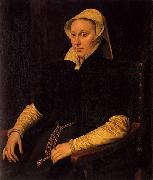 |
Anthonis Mor
|
|
(c. 1517 - 1577) was a Netherlandish portrait painter, much in demand by the courts of Europe. He has also been referred to as Antoon, Anthonius, Anthonis, or Mor van Dashorst, Antonio Moro, Anthony More, etc., but signed most of his portraits as, Anthonis Mor.
Mor was born in Utrecht, Netherlands by some estimation between 1516 and 1520. What is known of his early life is that his artistic education commenced under Jan van Scorel. His earliest work is probably a portrait at Stockholm, dated 1538.
A group of Knights of St. John, at Utrecht, supposed to have been painted about 1541; a picture of two pilgrims at the Gemäldegalerie, Berlin, dated 1544; together with the portrait of an unknown woman, in the Lille gallery, were probably among his earliest works although their authenticity has not been proved.
In 1547, he was received as a member of the Venerable Guild of St. Luke at Antwerp, and shortly afterwards (about 1548) he attracted the attention of Cardinal Granvelle, Bishop of Arras, who became his steady patron. Of the portraits executed during the early period of his career as Granvelle's protege, two are especially notable: one of the bishop himself (in the imperial gallery in Vienna), and one of the Duke of Alba, which now belongs to the Hispanic Society of New York. Between 1549 and 1550 Prince Philip II of Spain (1527-1598) traveled around the Netherlands to present himself as the future ruler. Mor painted his portrait in Brussels in 1549. He probably visited Italy (when exactly is not known) where he copied some works by Titian, notably the Danaë. |
|
|
|
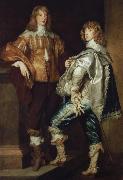 |
anthonis van dyck
|
|
Flemish painter and draughtsman, active also in Italy and England. He was the leading Flemish painter after Rubens in the first half of the 17th century and in the 18th century was often considered no less than his match. A number of van Dyck's studies in oil of characterful heads were included in Rubens's estate inventory in 1640, where they were distinguished neither in quality nor in purpose from those stocked by the older master. Although frustrated as a designer of tapestry and, with an almost solitary exception, as a deviser of palatial decoration, van Dyck succeeded brilliantly as an etcher. He was also skilled at organizing reproductive engravers in Antwerp to publish his works, in particular The Iconography (c. 1632-44), comprising scores of contemporary etched and engraved portraits, eventually numbering 100, by which election he revived the Renaissance tradition of promoting images of uomini illustri. His fame as a portrait painter in the cities of the southern Netherlands, as well as in London, Genoa, Rome and Palermo, has never been outshone; and from at least the early 18th century his full-length portraits were especially prized in Genoese, British and Flemish houses, where they were appreciated as much for their own sake as for the identities and families of the sitters.
|
|
 |
ANTHONISZ Cornelis
|
|
b. ca. 1499, Amsterdam, d. ca. 1555, Amsterdam
Dutch printmaker, painter and cartographer, maternal grandson of JACOB CORNELISZ. VAN OOSTSANEN. He was the dominant figure in the creation of north Netherlandish woodcuts from the mid-1530s until his death. His monogram, which combines the initials 'C' and 'T' with the staff and bell of St Anthony, was probably inspired by his father's first name. The greater part of his career was apparently spent in his native Amsterdam, where he probably trained with his grandfather. |
|
|
|
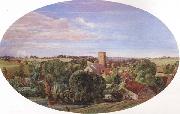 |
Anthony Frederick Augustus Sandys
|
|
1829-1904
English painter, illustrator and draughtsman. He was the son of Anthony Sands (1804-83), a minor local artist. He began his artistic education with his father and attended the Norwich School of Design from 1846. His precocious talent was recognized by the award of silver medals by the Society of Arts in 1846 and 1847. He moved to London in 1851, when he first exhibited at the Royal Academy, but he continued to spend time at Norwich until the death of his parents in 1883. After publishing in 1857 A Nightmare, a gentle caricature of John Ruskin and his Pre-Raphaelite prot?g?s William Holman Hunt, John Everett Millais and Dante Gabriel Rossetti and based on Millais's Sir Isumbras at the Ford (Port Sunlight, Lady Lever A.G.), he met Rossetti and became a member of his circle. |
|
|

